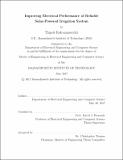Improving electrical performance of reliable solar-powered irrigation system
Author(s)
Rak-amnouykit, Thipok
DownloadFull printable version (6.564Mb)
Other Contributors
Massachusetts Institute of Technology. Department of Electrical Engineering and Computer Science.
Advisor
David J. Perreault.
Terms of use
Metadata
Show full item recordAbstract
A solar-powered irrigation system has been developed to address the lack of affordable irrigation solution for the marginal farmers in India. An MIT spinout, Khethworks, has designed an efficient water pump with low power rating, and created a low-cost irrigation system with the pump, a photovoltaic panel, and a battery. This thesis analyzes the electrical properties of such a configuration, and determines whether implementing maximum power point tracking (MPPT) can improve the system's performance. This is accomplished through modeling and conducting a system-level simulation. The amount of electrical energy generated by the photovoltaic panel and the amount of water delivered by the pump are chosen as the key measures of the system's performance. The simulation result indicates that implementing MPPT with the current version of the Khethworks irrigation system - using lower-power panels of the 48 or 60 cell variety - would not significantly increase its performance. However, an irrigation system with higher power rating (e.g., a 72-cell panel, such as with a 320 W rating) would significantly benefit from the MPPT, and the MPPT's benefits are consistent over the variation in location and time. Based on the finding, we identify circumstances under which each of the direct load line and the maximum power point tracking approaches are preferable, and recommend an action plan to Khethworks accordingly.
Description
Thesis: M. Eng., Massachusetts Institute of Technology, Department of Electrical Engineering and Computer Science, 2017. This electronic version was submitted by the student author. The certified thesis is available in the Institute Archives and Special Collections. Cataloged from student-submitted PDF version of thesis. Includes bibliographical references (pages 141-142).
Date issued
2017Department
Massachusetts Institute of Technology. Department of Electrical Engineering and Computer SciencePublisher
Massachusetts Institute of Technology
Keywords
Electrical Engineering and Computer Science.